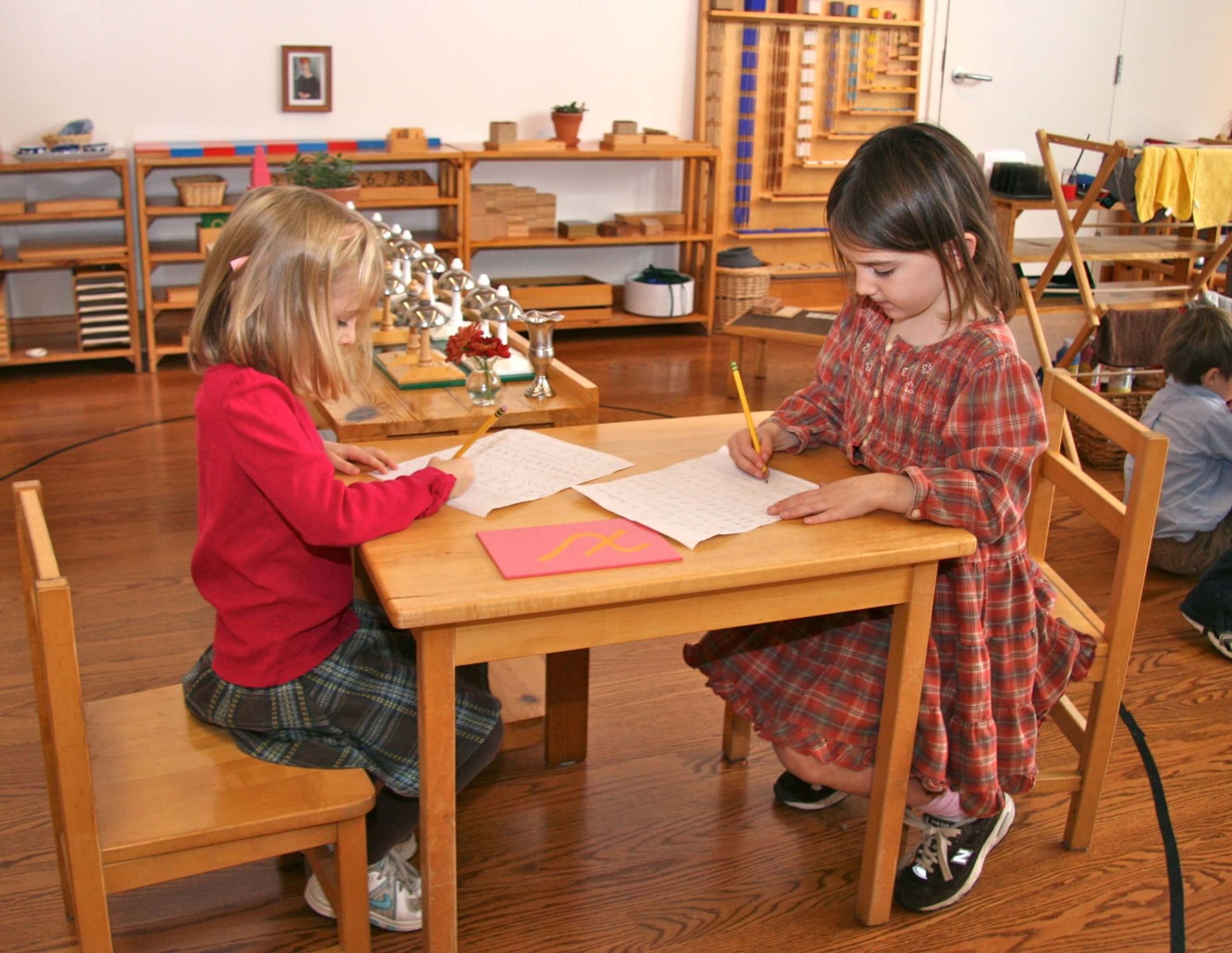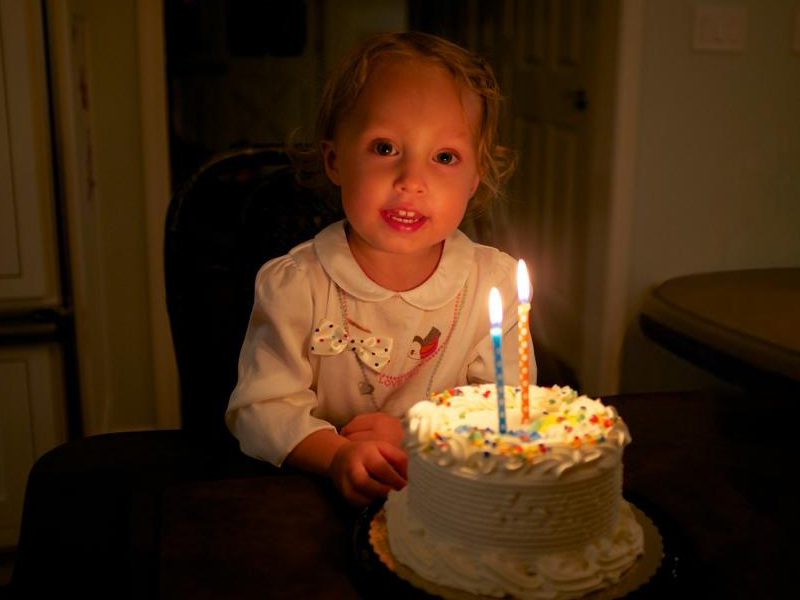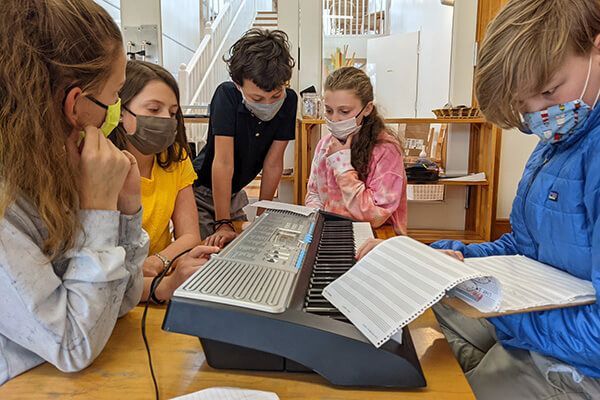
“They had no idea how much their lives would change.”
This thought has been uttered thousands of times in the last year—maybe millions. It describes how we all have felt at some point—at many points—since the Covid-19 pandemic started. But we are not unique in human history. Entire populations of countries have been affected by hardships throughout time—by war, by drought, and, yes, also by pandemics.
While we have not lived through a pandemic of this magnitude in our own lifetimes, this is not a novel event in history. And as real as the tragedy and trauma of the past year have been, there is some comfort in knowing that humanity has survived events like this before.
This particular sentence—“They had no idea how much their lives would change”—is so exquisite because it is a line in a musical written by 11- and 12-year-olds. When their lives changed in 2020 in extraordinary ways, these Montessori children had hearts and imaginations large enough to recognize that their experiences, however challenging, were not unique to themselves or to this moment in history.
When these elementary children were given the opportunity to write the musical for a school-wide performance for Forest Bluff School, they, of their own accord, chose to write it about pandemics throughout history: the Bubonic Plague, Yellow Fever, and the Flu of 1918. Our Head of School Paula Preschlack observed, “They used stories from the past to normalize what is happening to us now.” With a Montessori perspective, these students reminded themselves and each other that people have lived through similar circumstances before. And they found that, each time, people survived with kindness, courage, and new scientific discoveries. They saw that people did the best they could with what they had. They also recognized the importance of all the discoveries humans have made before our time. As one of the characters in the script observes, “Thank goodness for all the hard working humans of the past. Without their toil and thankless effort, none of the tools we rely on today would be possible.”
Re-envisioning the Drama Workshop
In 2020, our school was unable to hold the annual Drama Workshop. Normally at this event, Drama Director Phyllis Mount, her son Max Mount, and her grandchildren wrote scripts, songs, music, and dances for our 60 elementary students (ages 6-12). Each year, the drama directors read the scripts with the students, assign parts, assist in practice and music, and then complete the program with a week at Gorton Community Center where the children work intensively for five days and finish with a performance in the evening in front of friends and family.
This year, Forest Bluff School had the great fortune of being open and in-person for this entire school year, besides a few isolated class closings. While much of the learning has been the same for children, there are still differences due to Covid protocols: mask wearing, social distancing, assigned seating, and daily health checks, to name just a few.
By January of 2021, it became clear that even with the success our school has had in staying open in a safe and healthy way, the traditional Drama Workshop would be impossible. Additionally, we received the news that the member of the Mount family who was planning to be our drama director this year had to recover from an illness, making it impossible for him to come to our school to lead the children.
Our teachers and Head of School wanted desperately to give the students a chance at their Drama Workshop, especially in a year when so much has been taken away by the circumstances of the pandemic. They took the time to reimagine the possibilities and came up with a plan that was bold, exciting, and, ultimately, more “Montessori” than ever.
They considered the fall, when the oldest Upper Elementary children wanted to create a play together. Their teacher recognized their strong urge to work together collaboratively, and encouraged them with this big project. After more than a month of hard work, rehearsals at school, original costumes, and extra meetings outside of school, the children presented their original rendition of “When Pigs Fly” to the whole school outside. It was polished and entertaining, and they produced the entire endeavor with minimal adult assistance.

Given this experience, the teachers and our Head of School believed that, with the right support, the oldest Upper Elementary children (ages 11 and 12) could write and design this year’s all-school musical themselves. Then, instead of the usual performance for family members in the evening (which would be prohibited by Covid protocols) they could make it into a movie to distribute to the parents.
At first blush, this idea may seem preposterous: Invite six 11- and 12-year-olds to write a play for almost 60 students, produce it, and then make a movie? How many ways can one plan go wrong?
Fortunately for these children, the adults in the room had the highest faith in them. And they had a plan to support them.
(Upon hearing the plan for a re-envisioned drama performance, Max Mount and his daughter McKenna Aikens were incredibly gracious in offering their time and talents to support our students in this endeavor. In addition to providing structure and direction through virtual meetings, Max and McKenna will each be coming to town to help with the production during the week of filming. We are so grateful for the Mount family’s generosity and continued commitment to Forest Bluff School and its students.)
Putting the Plan to Work
Elementary support director John Dickson, who has a background in theater and film, took on the role of guide in this endeavor. He reported that the children were “ecstatic” when they were told they would be writing the musical. One 11-year-old girl recalled that they were “excited and shocked” when they heard the news. They were advised by the Mount family to write the script as three acts; the six eldest Upper Elementary children formed three groups of two to write each act. The children saw the logic of this plan. “We figured out that if we split up into smaller groups it was easier to manage,” one remembered.
First, in order to make the gargantuan task approachable, Mr. Dickson broke down the script-writing process into a series of lessons. After each lesson, the six students would break off into their groups of two to do the work of the lesson. The first lesson was choosing a theme. This meeting lasted about an hour, and many ideas were introduced. They settled on the broad theme of “overcoming challenges” and “perseverance.” Once they had these concepts for direction, one student who was currently doing research on American history during World War One suggested they write about the Flu of 1918. Quickly, several other global diseases were thrown into the mix. “The Yellow Fever hit the US after the revolution!” “Let’s do Ebola!” “How about Swine Flu!” After much deliberation and a quick lesson on the rank-choice voting technique, their final decision included the Bubonic Plague, Yellow Fever, and the Flu of 1918. All three topics were connected to research one or more of the third year students were currently doing.
Second was a lesson in structuring the story’s plot elements and employing one of the seven basic story archetypes. Mr. Dickson taught them the importance of exposition and character introduction: how to do the necessary research on the time and place of the story, and how to make characters interesting and believable. Third came a lesson in dialogue. This included both the specific syntax and formatting of a script, as well as discussions about pacing: introducing the conflict, the rising action, the climax, and the falling action. At each stage, the children came back to Mr. Dickson to check in and to ask questions. He went over each scene with them, discussing the scene’s purpose in the play and how to make sure the story was properly paced. The last script writing lesson was on stage blocking and camera directions. Here, Mr. Dickson showed them how to describe where the characters were in each scene with theater nomenclature, how to write in specific stage instructions, and how to indicate camera directions for the transitions and titles.
Adding Music
During their standing Friday production meeting with the Director, Max Mount, they discussed the direction of the script and music. Mr. Mount advised them on how to place their songs within the story. He said, “Use a song when words no longer suffice for the emotion of the scene.” They went through the script to find these moments in their story. All students contributed to the lyrics, and one 12-year-old boy eagerly claimed the job of writing original accompaniment for all the songs.
This student dove into the project with enthusiasm—and only a little bit of knowledge! Through purposeful work, he learned about notation in music. As the deadline for the finalized script approached, he realized that this was too large of a project. With humility and self-awareness, he stepped back from his original plan and decided to put the students’ original lyrics to preexisting instrumentals from the school play archives. He did persevere to create original accompaniments for two of the songs using staff paper, an electric keyboard, and support from his peers. This experience required the students to be flexible with their expectations, and it exposed them to the adjustments one must make in the face of a hard deadline. The student who wrote the accompaniments worked at the keyboard, sharing his struggles: “This is so hard! I’ve got to get this!” He finished with pride and determination. The music and lyrics are all wonderful.
The Opportunities for Growth
Growth in Group Work
With a project this large, in scope and group size, challenges are inevitable. The students had to work through difficulties both within their writing pairs, and within themselves. One of the challenges of working on any project with a deadline is the necessity of being motivated to do the work in time to complete the project. This is further complicated when in a group, because the members need to coordinate their efforts not only to meet the deadline, but also to be productive at the same time as one another.
The Upper Elementary children experienced this as well. For as enthusiastic as they were about this project, no one can be enthusiastic all the time. The students set aside time each day to focus on the play, but they also had to align their focus simultaneously with their partners. Sometimes, one partner would be ready to work, and the other would not. At other times, one would say, “I’m tired of doing all the work.” And the next time it might be the other!
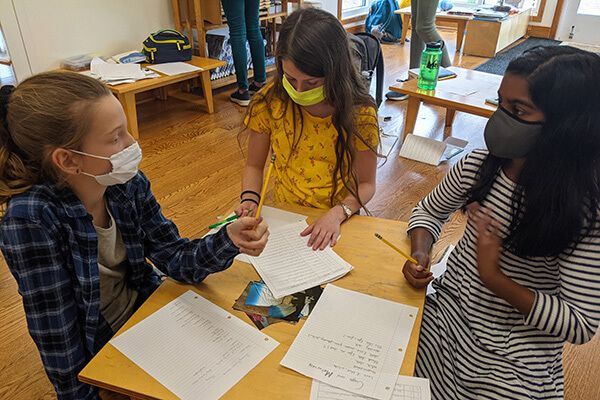
Additionally, the partners had to coordinate which efforts they wanted to pursue at a given time. In one pair, one of the students wanted to focus extensively on the exposition, doing all the research to set the time and place. The other wanted to move on quickly to the dialogue, and sometimes these disagreements led to discord. In these moments, they would take a break and then come back to each other to work later.
Dr. Maria Montessori recognized that the desire to be together is a huge motivator for focus in elementary-aged children. Because these students wanted to work in communion with their peers, and they wanted to produce a musical for their peers, they ultimately found a way to work through every single disagreement. And, fitting for a Montessori environment, the solutions for compromise were different for each pairing; some took turns on the work, others divvied up tasks and delegated to each other. They found what worked for themselves and for their specific relational dynamics—and they enjoyed the process. A mother of an 11-year-old writer shared, “Joy exudes every time she talks about what happened that day, that they laughed about or worked through.” This kind of growth can be uncomfortable, but these children learned, grew, and felt good about what they accomplished.
Personal Growth
Another opportunity for growth was the necessity for hearing feedback and integrating it. This project was not an individual activity. It was a group effort in service of the entire school. To that end, the work was not only about individual needs. It was about making something that would be useful and interesting for three classes of elementary children—more, if you include the community that will make up the audience!
As the students wrote their acts, they worked in conjunction with their teacher and the Mount family who guided them over Zoom. These conversations resulted in feedback on their writing, which was sometimes hard for them to hear. “Children feel strongly about their work,” Mr. Dickson observed. This passion is a beautiful thing, but this time their work was an essential part of a large production, and it had to make sense both for the storyline and for the scores of other people involved in putting on the production.
Feedback was given with mindful communication, time to process, and time for further discussion. The children learned to be more flexible and resilient with their vision and their work. They spent time in conversation, figuring out what they valued most and what other people valued most, and they learned about compromise within an artistic endeavor. Mr. Dickson shared that the children ultimately agreed on what to write in the script, with a feeling that everyone’s voice had been represented. The children grew in their abilities to adapt to each other, and to shape their own work for the greater good.
Responses to the Script
One mother shared about her daughter, “Her pride and excitement around the opportunity and responsibility has been palpable.” The writers took enormous pride and joy in this task and were thrilled to finally be able to share it with their peers. Once the script was completed, the students shared their work with a read-through in front of the rest of the Upper Elementary students.
At the end of the reading, a 10-year-old raised his hand, “I really loved that one song that was sad—it was so sad. And then the mom gets better, and then it was so happy. My emotions were going up and down!” This sentiment reflected so many of the wonderful aspects of this unique project; the students were able to hear for themselves that their work not only was correctly done as a screenplay, it also had the intended emotional effect. Their peers were responding to the story they had worked so hard to create.
Other children revealed similar sentiments. “I can’t believe they put together that play in just a few weeks,” a 10-year-old boy commented. “It’s my favorite play we’ve ever done. It’s really amazing that they did all that work in such a short time.” In this way, the other children were able to appreciate the final product and also the process. Younger Upper Elementary students have asked if they will get to write the play in future years, a testament to the excitement the writers have shown throughout the spring, as well as admiration for the play itself.
Moving Forward
Now that the script creation phase of the production is complete, the students have moved into the production phase: sets, props, and costumes. A student committee led by two third year students will create each of these elements. The students have revisited the script for all possible details that would inform the items they will need. After generating complete lists, they delegated creation plans to the students in their committees and the parent volunteers.
Managing a project of this size is no small task, especially for 11- and 12-year-olds. This is a lesson the students will remember forever on scrupulousness, attention to detail, collaboration, and effective team management. Each student committee chair employed their own style: some maintained more control over the process, while others trusted their team and gave more creative latitude to the other members. Every student committee chair will experience the real life consequences of their leadership style.
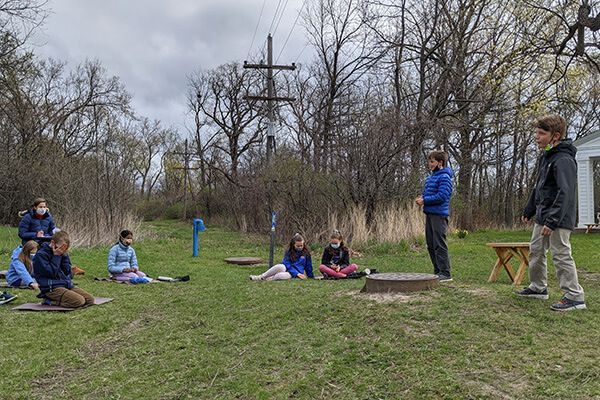
Mr. Dickson, who has founded a few small businesses in the past, is guiding them in this process and has encouraged the third year students to ask questions of themselves, such as, “How can I leverage the unique talents of everyone on my team?” “What bottle-neck situations can I predict and prevent by having the right resources on hand or by giving the right preliminary instruction to my team?” “What are the specific logistical considerations of a production item and how can I support my team with shared creation timelines?”
This process is almost always confusing and messy with many simultaneously moving parts. Having the experience of starting with their ideas in the abstract, working through the detailed planning, and overseeing the execution of their production will give them the confidence and ability to take on even grander visions in the future—a skill they will have for the rest of their lives.
At the end of May, the elementary students will meet at Gorton Community Center for five days with their teachers, members of the Mount family, a pianist, a choreographer, and a stage manager. They will work within Covid protocols and, once they finish their rehearsals, they will begin filming. At the end of the production there will be a DVD or flash drive available for purchase for families, friends, and the greater community. All funds will go towards the budget necessary for this project. (Purchasing several recordings is a wonderful way for the community to give the children the response their work has warranted—and also makes great gifts of entertainment for family members and friends of all ages for many years to come!)
Reflections
What these children have done is remarkable. They have taken a sustained, stressful current event, rife with uncertainty and tragedy, and they have set it within the context of history. They have placed their own lives within the context of this history, in a way that neither diminishes nor aggrandizes. They have undertaken a complicated and important project, and they have done it brilliantly and sensitively.
Mrs. Preschlack observed that, as Montessori students, these children have learned from the beginning that their education is in their own hands. They have, as she said, “a self-propelling approach to knowledge.” Knowing this, it is not surprising that these children did exactly what they did when tasked with writing a play during a pandemic. They looked back through human history to ask—Has this ever happened before? How did humans survive? And whose shoulders are we standing on now?
In answering these questions through their research and their story, they made it possible to look forward into the future. They saw that even though it felt like their world was falling apart, this had happened before, and humanity had persevered. Amidst the mistakes and pain and disappointment that humans had created, something beautiful had also happened: They had worked together, cared for each other, and lifted each other up. These children saw that and when they named their play, after reflecting on the effects of each pandemic, the title came easily: “Coming Together While the World Falls Apart.”
What do our Montessori children see when they look at the world in this moment? They aren’t blind to the news or deaf to our conversations. They know about uncertainty, disappointment, and tragedy. But what they also see is humanity coming together. It is this act, and this generation’s observation of it, that can give us that hope—that clear optimistic sense—that we will survive this too. We will make new discoveries. We will persevere. We stand on the achievements of those who came before us and we too have our own role to play. As a character in their script shares, “Let’s…make the world a better place for the humans that will be born after us.”

